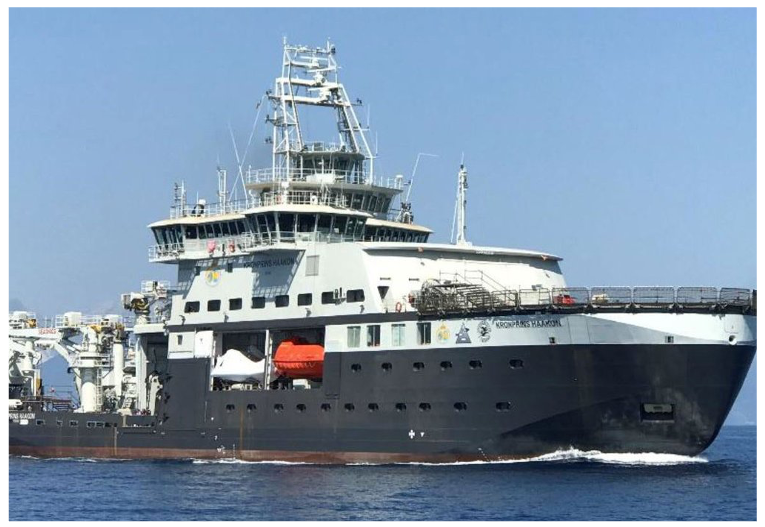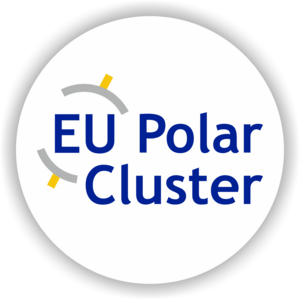RV Kronprins Haakon, NO

RV Kronprins Haakon, NO
The ship is equipped with state-of-the-art scientific instrumentation for oceanography, geophysics, marine biology, and marine geology including facilities for ROV, AUV and helicopter operations.
Contribution to POLARIN key research challenges: 1,2,4,5,6
Contact:
Operator contact, Senior advisor Christina A. Pedersen: christina.pedersen[at]npolar.no
Logistic evaluation contact, Section leader Operations and logistics Stig Flått: stig.flatt[at]npolar.no
Website
https://www.npolar.no/en/kronprins-haakon/
Location
The home port is Tromsø, and she operates in the marine areas in the Arctic and Southern Ocean. The icebreaker shape combined with the propulsion power, allows the vessel to maintain 3.5 knots through solid ice up to a thickness of one metre.
Facilities
The RV Kronprins Haakon is one of the world’s most advanced research vessels. The PC3 icebreaker-class vessel operates in ice-covered and open waters in the Arctic and Southern Ocean at all times of the year conducting long-term monitoring and collecting research data.
Staff Capacity: Accomondation for 15–17 crew and 35 scientists.
RV Kronprins Haakon has 15 laboratories supporting most research disciplines with some of the most comprehensive equipment packages supplied to any research vessel. The vessel has a moon pool and helicopter deck, is equipped with sonar, can host a remote-controlled large AUV and ROV, and can operate seismic and trawling equipment, weather balloons, etc. The vessel has considerable carrying capacity.
A detailed list of equipment is available here: https://kronprinshaakon.hi.no/en/havforskningsinstituttet/projects/kronprins-haakon/about-the-vessel/world-class-vessel
Services offered
Research facilities include: 15 laboratories, 3 container laboratories, 4 cold-rooms, 2 freezer rooms for samples, auditorium.
In total 55 cruises have been conducted in the vessels first five years of operation: two to the Southern Ocean, and the rest in the Arctic, including to the North Pole. The cruises have been conducted with Norwegian and international participants.
What is included in the Access
Unit of access: user/day
Modalities of access offered: In-person access.
Included in the access is before and after boarding safety training, polar outerwear, and access to the facilities onboard. The typical duration of work is 25 days at sea. The users can indicate which expedition they want to participate in, and they will be included in the cruise planning as early as possible. Available expeditions vary over the years depending on institute priorities.
Availability for access in the TA Call 2024
Access to 180 user/days, for a user group of up to 6 members.
Operational area: Access will be available for cruises in 2025 or 2026.
For 2025, the following cruises are anticipated:
- Fram Strait: 20 days, between mid-July and mid-September 2025
- Arctic Ocean (North-east of Svalbard: Nansen Basin slope region): 20 days, October-November 2025
For 2026, the following cruises are anticipated:
- Arctic Ocean: 35 days, July-August 2026
- Fram Strait: 20 days, August-September 2026
Time frame for access preparations
Time frame to receive the documentation from RI users (after access is granted): Typically around one month before the start of the cruise.
Time frame for logistic arrangements to access the RI: A few months prior to the cruise, depending on the type of arrangement. Use of larger equipments, such as ROVs, seismics and other heavy equipment on the ship should be clarified as early as possible.
Permits, licenses and training
Researchers must familiarise themselves with applicable regulations and obtain all relevant permits from the relevant authorities. Examples are: permits for work in other countries EEZs, permits for seismic work, permits for certain sea floor disturbing activities, or experiments on living animals.
Certification or training required from RI users:
Introduction for work on sea ice (normaly given onboard). Survival suit course are normally given. Other courses depending on type of work.
Medical guidelines
Valid medical certificate: https://www.sdir.no/en/shipping/seafarers/health/seafarers-health/

